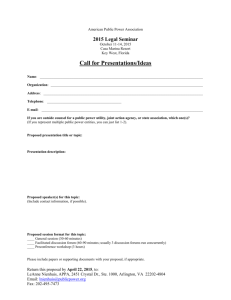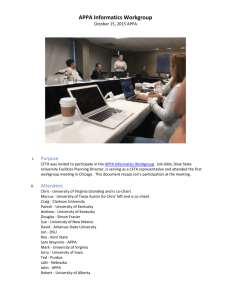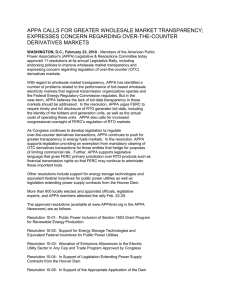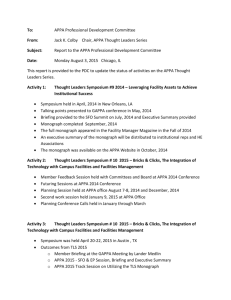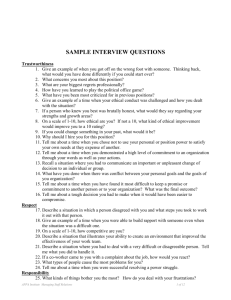On the Signaling Mechanism and the Absence of Photoreversibility in... AppA BLUF Domain
advertisement
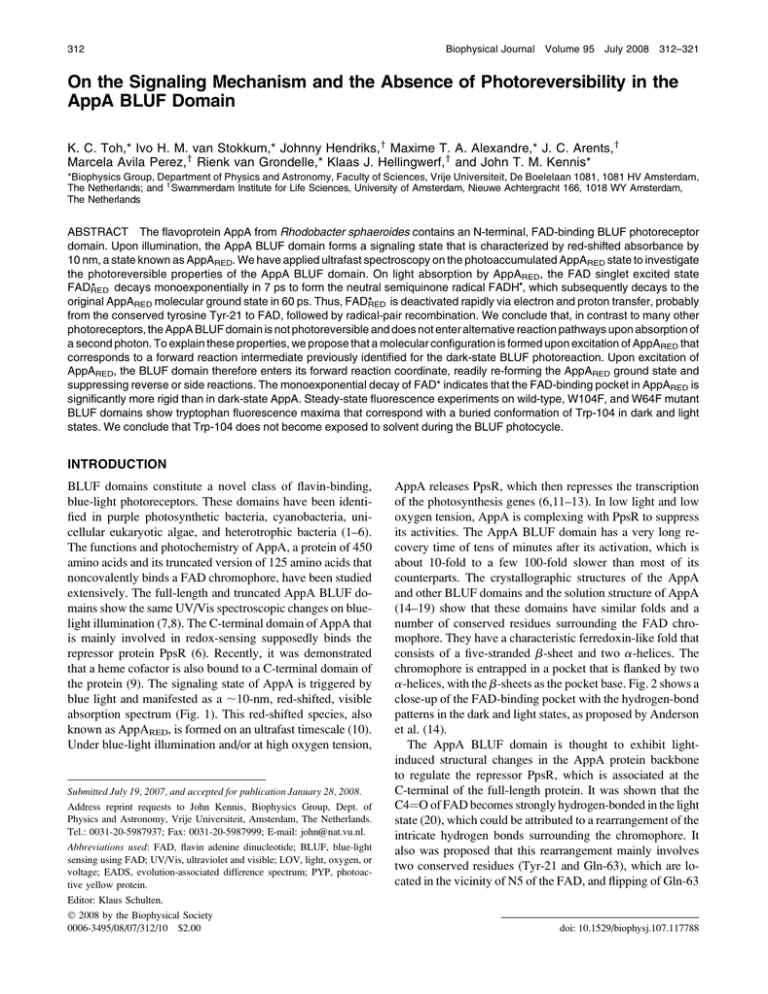
312 Biophysical Journal Volume 95 July 2008 312–321 On the Signaling Mechanism and the Absence of Photoreversibility in the AppA BLUF Domain K. C. Toh,* Ivo H. M. van Stokkum,* Johnny Hendriks,y Maxime T. A. Alexandre,* J. C. Arents,y Marcela Avila Perez,y Rienk van Grondelle,* Klaas J. Hellingwerf,y and John T. M. Kennis* *Biophysics Group, Department of Physics and Astronomy, Faculty of Sciences, Vrije Universiteit, De Boelelaan 1081, 1081 HV Amsterdam, The Netherlands; and ySwammerdam Institute for Life Sciences, University of Amsterdam, Nieuwe Achtergracht 166, 1018 WY Amsterdam, The Netherlands ABSTRACT The flavoprotein AppA from Rhodobacter sphaeroides contains an N-terminal, FAD-binding BLUF photoreceptor domain. Upon illumination, the AppA BLUF domain forms a signaling state that is characterized by red-shifted absorbance by 10 nm, a state known as AppARED. We have applied ultrafast spectroscopy on the photoaccumulated AppARED state to investigate the photoreversible properties of the AppA BLUF domain. On light absorption by AppARED, the FAD singlet excited state FADRED * decays monoexponentially in 7 ps to form the neutral semiquinone radical FADH , which subsequently decays to the original AppARED molecular ground state in 60 ps. Thus, FADRED * is deactivated rapidly via electron and proton transfer, probably from the conserved tyrosine Tyr-21 to FAD, followed by radical-pair recombination. We conclude that, in contrast to many other photoreceptors, the AppA BLUF domain is not photoreversible and does not enter alternative reaction pathways upon absorption of a second photon. To explain these properties, we propose that a molecular configuration is formed upon excitation of AppARED that corresponds to a forward reaction intermediate previously identified for the dark-state BLUF photoreaction. Upon excitation of AppARED, the BLUF domain therefore enters its forward reaction coordinate, readily re-forming the AppARED ground state and suppressing reverse or side reactions. The monoexponential decay of FAD* indicates that the FAD-binding pocket in AppARED is significantly more rigid than in dark-state AppA. Steady-state fluorescence experiments on wild-type, W104F, and W64F mutant BLUF domains show tryptophan fluorescence maxima that correspond with a buried conformation of Trp-104 in dark and light states. We conclude that Trp-104 does not become exposed to solvent during the BLUF photocycle. d INTRODUCTION BLUF domains constitute a novel class of flavin-binding, blue-light photoreceptors. These domains have been identified in purple photosynthetic bacteria, cyanobacteria, unicellular eukaryotic algae, and heterotrophic bacteria (1–6). The functions and photochemistry of AppA, a protein of 450 amino acids and its truncated version of 125 amino acids that noncovalently binds a FAD chromophore, have been studied extensively. The full-length and truncated AppA BLUF domains show the same UV/Vis spectroscopic changes on bluelight illumination (7,8). The C-terminal domain of AppA that is mainly involved in redox-sensing supposedly binds the repressor protein PpsR (6). Recently, it was demonstrated that a heme cofactor is also bound to a C-terminal domain of the protein (9). The signaling state of AppA is triggered by blue light and manifested as a ;10-nm, red-shifted, visible absorption spectrum (Fig. 1). This red-shifted species, also known as AppARED, is formed on an ultrafast timescale (10). Under blue-light illumination and/or at high oxygen tension, Submitted July 19, 2007, and accepted for publication January 28, 2008. Address reprint requests to John Kennis, Biophysics Group, Dept. of Physics and Astronomy, Vrije Universiteit, Amsterdam, The Netherlands. Tel.: 0031-20-5987937; Fax: 0031-20-5987999; E-mail: john@nat.vu.nl. Abbreviations used: FAD, flavin adenine dinucleotide; BLUF, blue-light sensing using FAD; UV/Vis, ultraviolet and visible; LOV, light, oxygen, or voltage; EADS, evolution-associated difference spectrum; PYP, photoactive yellow protein. AppA releases PpsR, which then represses the transcription of the photosynthesis genes (6,11–13). In low light and low oxygen tension, AppA is complexing with PpsR to suppress its activities. The AppA BLUF domain has a very long recovery time of tens of minutes after its activation, which is about 10-fold to a few 100-fold slower than most of its counterparts. The crystallographic structures of the AppA and other BLUF domains and the solution structure of AppA (14–19) show that these domains have similar folds and a number of conserved residues surrounding the FAD chromophore. They have a characteristic ferredoxin-like fold that consists of a five-stranded b-sheet and two a-helices. The chromophore is entrapped in a pocket that is flanked by two a-helices, with the b-sheets as the pocket base. Fig. 2 shows a close-up of the FAD-binding pocket with the hydrogen-bond patterns in the dark and light states, as proposed by Anderson et al. (14). The AppA BLUF domain is thought to exhibit lightinduced structural changes in the AppA protein backbone to regulate the repressor PpsR, which is associated at the C-terminal of the full-length protein. It was shown that the C4¼O of FAD becomes strongly hydrogen-bonded in the light state (20), which could be attributed to a rearrangement of the intricate hydrogen bonds surrounding the chromophore. It also was proposed that this rearrangement mainly involves two conserved residues (Tyr-21 and Gln-63), which are located in the vicinity of N5 of the FAD, and flipping of Gln-63 Editor: Klaus Schulten. Ó 2008 by the Biophysical Society 0006-3495/08/07/312/10 $2.00 doi: 10.1529/biophysj.107.117788 Absence of Photoreversibility in BLUF FIGURE 1 UV-vis absorption spectra of wild type AppA BLUF domain and W104F AppA BLUF domain mutant in dark and light states. The lower spectra show the light-minus-dark absorption difference spectra. (14,21,22), which causes a temporary disruption and rearrangement of hydrogen bonds that are directly interacting with C4¼O (20,23) (Fig. 2). Studies also have suggested that these events are further relayed to Trp-104 to induce structural changes in the protein backbone through the b5 strand (14,20,24,25). However, the actual location of Trp-104 in dark and light states remains controversial, as various BLUF x-ray structures show the conserved Trp in a solvent-exposed conformation (16,18,19) rather than in the vicinity of FAD (14,15,21). A time-resolved transient absorption spectroscopy study of AppA shows that the red-shifted state AppARED is formed directly from the FAD singlet excited state on a subnanosecond timescale (10). In contrast to AppA BLUF, an ultrafast transient absorption study of the Slr1694 BLUF domain 313 from Synechocystis shows the formation of intermediate anionic and neutral FAD semiquinone radicals before generating the red-shifted state (26). AppA probably goes through similar intermediates; these escape detection, however, because initial electron transfer from Tyr-21 to FAD is .103 slower than in Slr1694. Studies of site-directed mutants on conserved residues Tyr-21 and Trp-104 have shown that the photocycle is abolished upon mutation of Tyr-21, whereas the photocycle for the Trp-104 mutant is retained (8,24,27). An increase in the quantum yield of the AppARED formation from 0.24 in the wild-type to 0.38 was reported in the W104F mutant (27,28). Tyr-21 mutants show evidence of electron and proton transfer from Trp-104 to FAD (28,29). Moreover, both mutants exhibit a multiexponential decay of the FAD singlet excited state due to conformational flexibility of Tyr and Trp (28). These observations indicate that electron and proton transfer from Tyr is indispensable in generating the red-shifted state of BLUF domains, and that electron transfer from Trp-104 provides a nonproductive, excited state, deactivation pathway. The result is further confirmed by the Tyr-21/Trp-104 double mutant, which shows a total inhibition of photoactivation of AppA with a monoexponential decay of FAD* producing the FAD triplet state, indicating the absence of any appreciable photochemistry between the chromophore and nearby residues (28). In addition to the extensively studied dark-state photochemistry of AppA and other BLUF domains, the investigation into the light-state photochemistry of AppA BLUF domains also is highly interesting. It was observed in a previous study (29) that the light-state photochemistry of AppA might involve electron and proton transfer and the formation of neutral flavin semiquinone. One property that is of great interest is the photoreversibility of a photoreceptor. Photoreversibility in this context means the reversion of the inductive effect of the first light stimulus by a second light stimulus or by more subsequent light stimuli. It has been shown in other blue-light photoreceptors, such as flavin FIGURE 2 The x-ray structure of the Rhodobacter sphaeroides AppA BLUF domain. The left and right panels represent a close-up of the vicinity of the FAD chromophore in the dark and light orientations of the conserved glutamine, as proposed by Anderson et al. (14). Biophysical Journal 95(1) 312–321 314 mononucleotide-binding LOV domains, that the signaling state in its adduct cysteine formation is reversible by a second, near-ultraviolet (UV) excitation (30). Photoreversible processes are well-documented in other photoreceptors such as the phytochromes (31–35), rhodopsins (36–39), PYP (40), and, very recently, Arabidopsis cryptochrome (41). Such properties might have implications related to their physiological function because most light-sensing proteins are constantly under light pressure during the daytime. In our study, we have used ultrafast transient absorption spectroscopy to investigate the photochemistry of the AppARED state by continuous blue-light background illumination. We have further monitored the relative position of Trp-104 in dark and light states by studying the tryptophan fluorescence of wild-type AppA and the W64F and W104F mutants, which bind only one of the two tryptophans in the AppA BLUF domain, located at the b3 and b5 strands, respectively. MATERIALS AND METHODS The detailed preparations of the wild-type AppA and W104F AppA BLUF proteins were described previously (10,27). The W64F AppA BLUF protein was prepared similarly to the W104F AppA BLUF protein as described by Laan et al. (27). The mutagenesis primers that we used had the following nucleotide sequences: 59-GGGCGTCTTCTTCCAGTTCCTCGAGGGCCACCCCGCCG-39 and 59- CGGCGGGGTGGCCCTCGAGGAACTGGAAGAAGACGCCC-39. Mutated bases are indicated in bold. The constructs were verified by sequencing (BaseClear, Leiden, The Netherlands). Ultrafast transient absorption spectroscopy was done with a 1-kHz Ti:sapphire-base regenerative amplification system (Coherent Inc., Mountain View, CA; BMI, Evry, France) as described previously (42). A pump beam of 400 nm with energy of ;500 nJ obtained from a frequency doubling of the 800 nm Ti:sapphire output was used to excite the sample. A lowintensity white-light probe beam was generated by focusing an 800-nm beam on a CaF2 crystal and overlapped with the pump beam in the sample with an optical density (OD) ;0.4 at 450 nm in a 2-mm pathlength cell. A blue light emitting diode (;1 W) with a maximal emission at 460 nm was used to generate continuous background illumination to convert the majority of the proteins to their light state. A flow cuvette was used during the measurement for a faster refreshing rate of the sample (;4 ml). Absorption changes were recorded for a delay #4 ns, with a time resolution of ;150 fs. We did experiments with and without background illumination in H2O buffer (10 mM Tris HCl at pH 8), in D2O buffer for the wild-type AppA, and in H2O buffer for the W104F mutant only. All time-gated spectra were analyzed globally using a sequential kinetic scheme, 1/2/3/. . . and so on, with rate constants k1 . k2 . k3 . . . . and so on. The amplitudes associated with the concentration of each component are called EADS. Importantly, the dark- and light-state experiments were analyzed simultaneously. In this target analysis, we estimated a remaining small fraction of dark-state photocycle in the light-state experiment of ;10%. Thus, we routinely estimated four lifetimes and associated EADS for the dark-state photocycle and two lifetimes and associated EADS for the light-state photocycle. Details of the global and target analysis methods can be found elsewhere (43). The steady-state fluorescence measurements were done using a Fluorolog Tau-3 lifetime system (Horiba Jobin Yvon, Longjumeau, France). Samples ,0.1 OD/cm at 280 nm in H2O buffer, which was placed in a quartz cuvette of 1-cm pathlength, were excited at 280 nm, and the emissions were monitored from 290 nm to 540 nm. All samples were prepared from a dilution of wildtype, W64F, and W104F AppA with protein concentrations of 0.40 OD/cm at the 446-nm absorption peak of the flavin. Biophysical Journal 95(1) 312–321 Toh et al. RESULTS Ultrafast spectroscopy of the AppA photoactivated state Femtosecond transient absorption spectroscopy was carried out on the wild-type AppA that was converted to its photoactivated state AppARED by means of strong blue background illumination. Fig. 3 a shows kinetic traces on excitation at 400 nm for AppA in H2O buffer in the absence and presence of background illumination (black and gray lines, respectively). The former reproduced our previous result ((10), Supplementary Material, Data S1). Strikingly, the background-illuminated AppA showed a marked difference from the AppA sample without background illumination as evidenced in the kinetic traces shown in Fig. 3 a, gray lines. Fig. 3 b shows the result of a target analysis of the timeresolved data that uses two lifetimes to describe the spectral evolution of background-illuminated AppA (black lines). Each lifetime is associated with an EADS. The first EADS (Fig. 3 b, black solid line) corresponds to the singlet excited state of AppARED, hereafter denoted as FAD*RED. The negative band at ;460 nm corresponds to ground state bleaching of FAD, whereas the positive bands at 523 nm and at wavelengths longer than 640 nm is typical FAD* excited state absorption. The stimulated emission band of FAD*RED is located at 565 nm. These bands are very similar to those of FAD* in dark-state AppA as described by Gauden et al. (10), except that the positions of the bands are red-shifted by ;10 nm, confirming that the singlet excited state of lightadapted AppA (i.e., AppARED) was populated. The spectral shapes are also similar to those reported earlier for FAD in solution and flavin in the LOV2 domain of phototropin (44,45). The first EADS evolves into the second EADS (Fig. 3 b, black dashed line) in 7 ps, which shows a reduced bleaching at ;460 nm and a broad absorption band between 500 nm and 650 nm. This spectral signature corresponds to that of the neutral semiquinone radical FADH (26,46). The second EADS decays to the baseline (i.e., to the molecular ground state of AppARED) in 60 ps. Fig. S2 in Data S1 shows the results for the AppA BLUF domain dissolved in D2O buffer. There is no significant change in the rate of the formation of the semiquinone intermediate FADH from FAD* (9 ps in D2O vs. 7 ps in H2O). However, the lifetime of the second EADS, 150 6 20 ps, shows a strong kinetic isotope effect of 2.5 upon hydrogen/deuterium (H/D) exchange. Our results show the neutral semiquinone radical FADH as an intermediate in the light-state photochemistry of wildtype AppA. This indicates that, upon excitation of FAD, fast electron transfer occurs, followed by proton transfer to the FAD chromophore from a nearby amino acid residue to form the FADH semiquinone intermediate in 7–9 ps. The FADH semiquinone intermediate subsequently decays to the original ground state of AppARED, probably through a radical-pair recombination mechanism in 60 ps. d d d d d Absence of Photoreversibility in BLUF 315 FIGURE 3 (a) Kinetic traces recorded in the AppA BLUF domain in H2O buffer on excitation at 400 nm in the dark state (black lines) and the light state (gray lines). Conversion to the light state was carried out through background illumination. The solid lines denote experimental data; the gray solid lines contain an estimated fraction of 10% of the dark-state photocycle; and the dashed lines are fits from a global analysis. Note that the time axis is linear up to 5 ps and logarithmic thereafter. (b) EADS that follow from a global analysis of the light-state (background-illuminated) time-resolved data of wild-type (black lines) and W104F mutant (gray lines) AppA BLUF in H2O buffer. Similar results were observed in the W104F mutant of AppA under background illumination. Fig. 3 b shows the results for the W104F mutant global analysis, which includes two kinetic components. The first EADS (gray solid line) is similar to that observed in wild-type AppA and is assigned to FAD*RED accordingly. This EADS evolves in 4 ps to the second EADS (gray dashed line), which shows a spectral signature that can be assigned to the neutral semiquinone radical FADH , as in wild-type AppA. This component decays in 45 ps to the baseline. d Biophysical Journal 95(1) 312–321 316 Steady-state tryptophan fluorescence of wild-type AppA, W64F, and W104F Toh et al. blue-light background illumination. The light-state measurement showed different excited-state dynamics compared to the dark state. The occurrence of the FADH neutral semiquinone intermediate has not been observed in the photochemistry of dark-state AppA (10). FAD radical intermediates, however, have been observed in the forward reaction of the Synechocystis Slr1694 BLUF domain (26). The background illumination experiments of AppA showed that, upon excitation of AppARED, FADH was formed on the picosecond timescale, which in turn relaxed in 60 ps to the original ground state of AppARED, likely via radical-pair recombination. A pronounced isotope effect was observed in the decay of FADH , thus suggesting proton or hydrogen transfer from FADH to the protein. As judged from the reduced bleach of FADH compared to that of FAD* (Fig. 3 b), there is a deactivation pathway for the FAD* singlet excited state of AppARED that causes ;65% of the FAD* population to relax back to ground state of AppARED before formation of FADH . The photochemistry of the AppARED state is summarized schematically in Fig. 5. For the Synechocystis Slr1694 BLUF domain, the formation of the anionic FAD radical was followed by the neutral FADH semiquinone radical on a picosecond timescale, demonstrating that electron transfer constituted the primary light-driven reaction (26). Here, we did not observe the anionic FAD radical in the spectral evolution of light-state AppA. However, given the almost identical FAD*RED decay rates for AppA in H2O and D2O (7 and 9 ps, respectively), we consider it likely that a light-driven electron transfer would be followed by proton transfer to FAD. The FAD radical was unobserved probably because of the rate-limiting, initial electron transfer. Because of the rise of the neutral semiquinone FADH radical in ,10 ps, it is obvious that electron and proton transfer occurs from the immediate vicinity of the FAD . There are two candidate donors—the conserved Tyr-21 and Trp-104—which are anchored with the flavin through a hydrogen-bonded network (14). The light-state W104F results were very similar to those of wild-type AppA, especially for the rise and the decay of FADH on approximately the same timescales (Fig. 3 b). Thus, electron and proton transfer most likely originated from Tyr-21. This result also suggests that Tyr-21 is unlikely to form a p-p stacking with the flavin in the AppARED state, as was proposed previously (8). Such a configuration would have resulted in an electron transfer in ,1 ps and a charge recombination in ,10 ps as observed in the riboflavin-binding protein (47). The excited-state lifetime of FAD* in the AppARED state (7 ps) is more than an order of magnitude shorter than that of AppA in the dark state (which has a dominant 590-ps decay component). Such a dramatic increase of electron transfer rate may be explained by changes of the FAD and Tyr-21 redox potentials that follow from the altered hydrogen-bond patterns, possibly combined with a slight decrease of the donor-acceptor distance. d In view of recent studies suggesting the possibility of the flipping of Trp-104 and its resulting solvent exposure in either the dark or light state of AppA, in concerted movement with Met106 (16,17), we made tryptophan fluorescence measurements to assess the tryptophan microenvironment of AppA in its dark and light (photoactivated) states. Wild-type AppA has two tryptophans: Trp-104, which is in close proximity to FAD on the b5 strand, and Trp-64, located on the b3 strand. Fluorescence experiments were done on wildtype AppA and the W64F and W104F mutants, with excitation at 280 nm. Fig. 4 a shows the results for wild-type AppA in dark (solid line) and light (dashed line) states. We observed an emission maximum at 334 6 2 nm in both the dark and light states, and a slight decrease by 7% of the fluorescence intensity in the latter. This result for the wildtype AppA BLUF domain is consistent with that previously reported by Kraft et al. (8). The W64F mutant (which binds Trp-104 as its only tryptophan) has an emission peak at 328 6 2 nm in the dark state (Fig. 4 b, solid line). Upon photoactivation, the fluorescence maximum shifts to 331 6 2 nm, and the intensity decreases by ;25% (Fig. 4 b, dashed line). The W104F mutant shows a tryptophan emission maximum at 336 6 2 nm in both dark and light states (Fig. 4 c). The intensity decreases slightly in the light state, with little or no shifting for the peak position. DISCUSSION The photochemistry of light-state AppA We did an ultrafast transient absorption measurement on the wild-type and W104F AppA BLUF domain with and without d d d d d d d d d d d d FIGURE 4 Tryptophan fluorescence measurements on (a) wild-type, (b) W64F mutant, and (c) W104F mutant of the AppA BLUF domain at 280 nm excitation in dark (solid lines) and light (dashed lines) states. Biophysical Journal 95(1) 312–321 Absence of Photoreversibility in BLUF 317 FIGURE 5 Photochemistry of the AppA BLUF domain in its light state with proposed molecular configurations. See text for details. BLUF domains are not photoreversible transfer from Tyr, followed by proton transfer resulting in an FADH -Tyr radical pair and hydrogen-bond switch. After 65 ps, there is a radical pair recombination that results in the red-shifted product state (26). It is interesting to note that the lifetime of FADH of the forward reaction in Synechocystis (65 ps) is essentially identical what we observed (60 ps). Also, the kinetic isotope effect is identical in both cases, as the time constants become 180 ps and 150 ps in D2O for Synechocystis and AppA BLUF, respectively. Our observations strongly suggest that the FADH species in the forward reaction of Synechocystis and in the AppARED photochemistry represent identical molecular configurations. We thus propose that, on excitation of FAD in the AppARED state, the system enters the forward reaction coordinate after electron/ proton transfer from Tyr-21 to FAD, resulting in FADH , and that the AppARED state is readily re-formed in 60 ps without a switch of the hydrogen-bond network. In this way, potential deleterious side reactions also are suppressed. The molecular transformations associated with such events are depicted in Fig. 5,which shows that the hydrogen-bond pattern on electron/proton transfer from Tyr-21 to FAD resulting in FADH -Tyr in AppARED is identical to that proposed for the Synechocystis BLUF domain (26). Fig. 6 shows the overall photocycle scheme for AppA BLUF domains with inclusion of the light-state photochemistry. d An important result from this study concerns the observation that the AppA BLUF domain is not photoreversible, nor does it enter alternative reaction pathways on absorption of a second photon. The nonphotoreversibility probably represents an inherent characteristic of all BLUF domains and sets this family of photoreceptors apart from essentially all other photoreceptors, including phytochromes, rhodopsins, PYP, LOV domains, and cryptochromes (30–41). Interestingly, although color discrimination between dark and light states (representing receptor and signaling states) is significant in most photoreceptors, it is not significant in BLUF domains. BLUF domains only show a modest red-shift by 10 nm of the otherwise broad oxidized flavin absorption, limiting any potential physiological utility of photoreversible properties. It is important to note that the chemical state of the chromophore in BLUF domains is identical in the dark and the light states (i.e., oxidized FAD); only the hydrogen-bond pattern with nearby protein side chains is different. In contrast, the chromophore in other photoreceptors has undergone an isomerization often coupled with (de)protonation (rhodopsin, phytochrome, and PYP), a reduction (cryptochrome), or covalent bond formation (LOV domains), all of which are chemical modifications more readily influenced by light absorption. The comparison of the Synechocystis Slr1694 BLUF domain photochemistry in its dark state with that of light-state AppA presented in our study provides important clues on the molecular mechanistics that underlie the absence of photoreversibility of BLUF domains. The photocycle in the darkstate of Synechocystis BLUF domains is initiated by electron d d d d d d The FAD-binding pocket tightens on photoactivation Our study also demonstrates that the decay of FAD* is strictly monoexponential in the AppARED state, occurring in Biophysical Journal 95(1) 312–321 318 Toh et al. FIGURE 6 General photocycle scheme for BLUF domains in dark and light states. See text for details. 7 ps. This result contrasts strongly with the multiexponential decays found for FAD* in dark-state BLUF domains, i.e., wild-type AppA, AppA mutants, and Slr1694 (10,26,28,48). The multiexponential decay of FAD* in wild-type AppA and the Y21 and W104 single mutants was explained by the slow timescale (microseconds–milliseconds) exchange of the conserved Tyr and Trp residues between different conformational states (15). This led to subpopulations with variations in the distance between FAD and the aromatic residues and an ensuing distribution of light-driven electron transfer rates as a result (10,28). In light-state AppA, Tyr-21 becomes strongly hydrogen-bonded to Gln-63, leading to a decrease of its conformational freedom (21). Also, Gln-63 becomes strongly hydrogen-bonded to C4¼O of FAD (20). These events may result in an overall tightening of the FAD-binding pocket with a well-defined distance between FAD and Tyr-21 and, for this reason, a single-exponential electron transfer rate. These observations suggest that the BLUF domain ‘‘collapses’’ onto a single, well-defined structure upon photon absorption from multiple conformations in the vicinity of FAD in the dark state. Trp-104 remains buried in dark- and light-state AppA The emission spectra of wild-type AppA and its tryptophan mutants in both dark and light states peak between 328 and 336 nm. Given the comprehensive study by Reshetnyak et al. (49) in which tryptophan fluorescence maxima are correlated with tryptophan positions in a large number of protein structures, the Trp in AppA can be grouped in class I fluorophores that have averaged emission spectra maxima at 331 6 4.8 nm. This class of fluorophores has low total accessibility of indole rings by the solvent (,10%) and yet has enough structural mobility to form hydrogen-bonded exciplexes and dipole relaxation during the lifetime of a fluorophore in the excited state. Biophysical Journal 95(1) 312–321 In particular, the tryptophan of interest for the BLUF signaling mechanism—Trp-104—is monitored selectively in the W64F mutant. The position of the Trp-104 fluorescence maxima in the dark state (328 nm) indicates that Trp-104 falls well within the class I criteria and assumes a buried conformation within the confinement of the protein (49,50). Thus, our results indicate that Trp-104 is located in close proximity to FAD in the dark state, in agreement with the x-ray structure (14) and the solution structure (15,21) of wild-type AppA. In the nomenclature of Reshetnyak et al. (49), partially solvent-exposed Trp belongs to class II, with a Trp fluorescence maximum between 337 and 348 nm, as has been observed for light-state PYP (51), for example. Strikingly, Trp-104 has a fluorescence maximum at 331 nm in the AppA light state and so belongs to class I rather than class II. Although the fluorescence of Trp-104 shifts to the red by 3 nm, we conclude that it does not become solvent-exposed upon illumination. Our observations provide evidence against light-induced, reversible solvent exposure of the conserved Trp (or vice versa), as proposed on the basis of crystal structures of the AppA C20S mutant (16) and the Synechocystis Slr1694 BLUF domain (17). Upon photoactivation, the tryptophan fluorescence intensity of the W64F mutant decreases significantly by ;25%, indicating that the fluorescence from Trp-104 is more strongly quenched in the light state than in the dark state. Tryptophan fluorescence quenching is a common phenomenon that is caused by electron transfer from the indole ring to a nearby backbone amide in most cases and to other acceptors less frequently (52). The decrease of Trp-104 fluorescence in the light state may be explained by a local conformational change of Trp-104 that brings it in closer proximity to such an electron acceptor. Our results show that the microenvironment in Trp-104 does not change dramatically between dark and light states; the change occurred on a timescale of minutes during which the illumination took place and the fluorescence spectra were Absence of Photoreversibility in BLUF 319 recorded. The AppA BLUF domain crystal structures (Protein Data Bank: 1YRX, 2BUN, and 2IYG) show that Trp-64 is located on the b3 strand and at the center of the dimerization interface (14–16). Thus, dimerization of the molecule would restrict the movement of Trp-64 but not of Trp-104, excluding the possibility that Trp-104 remains buried as a consequence of dimerization. Our results for the W64F mutant are slightly different from those reported by Yuan et al. (17) for the Synechocystis Slr1694 BLUF domain. Slr1694 binds a single Trp at position 91, which is equivalent to Trp-104. Fluorescence maxima at 333 and 335 nm for dark and light states were observed, which are red-shifted by 4–5 nm with respect to those of the W64F mutant. The origin of these differences remains unclear; we note, however, that the fluorescence results observed by Yuan et al. (17) also can be categorized in class I. The W104F mutant, which monitors the fluorescence from Trp-64, shows a fluorescence maximum at 336 nm in both dark and light states. Trp-64 falls well within class I and is on the edge of class II, indicating that Trp-64 experiences a more polar environment than Trp-104. The tryptophan fluorescence spectra of wild-type AppA and the W104F mutant are nearly identical, which indicates that the total fluorescence intensity is very likely dominated by Trp-64 with only a minor contribution by Trp-104 in wild-type AppA. CONCLUSIONS We have investigated the photochemistry of the AppA BLUF domain that was converted to its light-state AppARED by continuous background illumination. We have demonstrated that, under these circumstances, the neutral semiquinone radical FADH is generated from the FAD* singlet excited state on the picosecond timescale, which in turn relaxes back to its original ground state AppARED in 60 ps. We conclude that the BLUF domain, in contrast to most other known photoreceptors, is not photoreversible and does not enter alternative reaction paths upon absorption of a second photon. To explain the observed phenomena, we propose that, upon excitation of AppARED, a molecular configuration involving the radical pair FADH -Tyr is formed that corresponds to a forward reaction intermediate previously identified for the dark-state BLUF photoreaction (26). Thus, upon excitation of AppARED, the BLUF domain enters its forward reaction coordinate, readily re-forming the AppARED ground state and so suppressing any reverse or side reaction. We observe a single exponential decay of FAD* in the AppARED state, which is consistent with a significant tightening of the FAD-binding pocket in the light as compared to the dark state. Finally, tryptophan fluorescence experiments on the W64F mutant have indicated that the highly conserved tryptophan, Trp-104, does not become solvent-exposed at any time during the photocycle. This observation challenges the light-induced, concerted Trp-104–Met-106 ‘‘flip’’ model d d d that was proposed on the basis of BLUF crystal structures (16,17). SUPPLEMENTARY MATERIAL To view all of the supplemental files associated with this article, visit www.biophysj.org. The authors thank Mikas Vengris, Emmanouil Papagiannakis, and Magdalena Gauden for help in the initial preparation for the measurements; Jos Thieme, for his invaluable technical support; and Jeffrey Grinstead, for fruitful discussions. This work was supported by a VIDI grant from the Life Sciences Council of the Netherlands Organization for Scientific Research (NWO-ALW) (KC.T. and J.T.M.K.). REFERENCES 1. Rajagopal, S., J. M. Key, E. B. Purcell, D. J. Boerema, and K. Moffat. 2004. Purification and initial characterization of a putative blue light– regulated phosphodiesterase from Escherichia coli. Photochem. Photobiol. 80:542–547. 2. Gomelsky, M., and G. Klug. 2002. BLUF: a novel FAD-binding domain involved in sensory transduction in microorganisms. Trends Biochem. Sci. 27:497–500. 3. Gomelsky, M., and S. Kaplan. 1998. AppA, a redox regulator of photosystem formation in Rhodobacter sphaeroides 2.4.1, is a flavoprotein— identification of a novel FAD binding domain. J. Biol. Chem. 273: 35319–35325. 4. Iseki, M., S. Matsunaga, A. Murakami, K. Ohno, K. Shiga, K. Yoshida, M. Sugai, T. Takahashi, T. Hori, and M. Watanabe. 2002. A bluelight–activated adenylyl cyclase mediates photoavoidance in Euglena gracilis. Nature. 415:1047–1051. 5. Okajima, K., S. Yoshihara, Y. Fukushima, X. X. Geng, M. Katayama, S. Higashi, M. Watanabe, S. Sato, S. Tabata, Y. Shibata, S. Itoh, and M. Ikeuchi. 2005. Biochemical and functional characterization of BLUF-type flavin-binding proteins of two species of cyanobacteria. J. Biochem. (Tokyo). 137:741–750. 6. Masuda, S., and C. E. Bauer. 2002. AppA is a blue light photoreceptor that antirepresses photosynthesis gene expression in Rhodobacter sphaeroides. Cell. 110:613–623. 7. Laan, W., M. A. van der Horst, I. H. van Stokkum, and K. J. Hellingwerf. 2003. Initial characterization of the primary photochemistry of AppA, a blue-light–using flavin adenine dinucleotide-domain containing transcriptional antirepressor protein from Rhodobacter sphaeroides: a key role for reversible intramolecular proton transfer from the flavin adenine dinucleotide chromophore to a conserved tyrosine? Photochem. Photobiol. 78:290–297. 8. Kraft, B. J., S. Masuda, J. Kikuchi, V. Dragnea, G. Tollin, J. M. Zaleski, and C. E. Bauer. 2003. Spectroscopic and mutational analysis of the blue-light photoreceptor AppA: a novel photocycle involving flavin stacking with an aromatic amino acid. Biochemistry. 42:6726– 6734. 9. Han, Y., M. H. Meyer, M. Keusgen, and G. Klug. 2007. A haem cofactor is required for redox and light signaling by the AppA protein of Rhodobacter sphaeroides. Mol. Microbiol. 64:1090– 1104. 10. Gauden, M., S. Yeremenko, W. Laan, I. H. M. van Stokkum, J. A. Ihalainen, R. van Grondelle, K. J. Hellingwerf, and J. T. M. Kennis. 2005. Photocycle of the flavin-binding photoreceptor AppA, a bacterial transcriptional antirepressor of photosynthesis genes. Biochemistry. 44:3653–3662. Biophysical Journal 95(1) 312–321 320 11. Gomelsky, M., and S. Kaplan. 1995. AppA, a novel gene encoding a trans-acting factor involved in the regulation of photosynthesis geneexpression in Rhodobacter sphaeroides 2.4.1. J. Bacteriol. 177:4609– 4618. 12. Braatsch, S., M. Gomelsky, S. Kuphal, and G. Klug. 2002. A single flavoprotein, AppA, integrates both redox and light signals in Rhodobacter sphaeroides. Mol. Microbiol. 45:827–836. 13. Gomelsky, M., and S. Kaplan. 1997. Molecular genetic analysis suggesting interactions between AppA and PpsR in regulation of photosynthesis gene expression in Rhodobacter sphaeroides 2.4.1. J. Bacteriol. 179:128–134. 14. Anderson, S., V. Dragnea, S. Masuda, J. Ybe, K. Moffat, and C. Bauer. 2005. Structure of a novel photoreceptor, the BLUF domain of AppA from Rhodobacter sphaeroides. Biochemistry. 44:7998–8005. 15. Grinstead, J. S., S. T. D. Hsu, W. Laan, A. M. J. J. Bonvin, K. J. Hellingwerf, R. Boelens, and R. Kaptein. 2006. The solution structure of the AppA BLUF domain: insight into the mechanism of lightinduced signaling. ChemBioChem. 7:187–193. 16. Jung, A., J. Reinstein, T. Domratcheva, R. L. Shoeman, and I. Schlichting. 2006. Crystal structures of the AppA BLUF domain photoreceptor provide insights into blue light–mediated signal transduction. J. Mol. Biol. 362:717–732. 17. Yuan, H., S. Anderson, S. Masuda, V. Dragnea, K. Moffat, and C. Bauer. 2006. Crystal structures of the Synechocystis photoreceptor Slr1694 reveal distinct structural states related to signaling. Biochemistry. 45:12687–12694. 18. Kita, A., K. Okajima, Y. Morimoto, M. Ikeuchi, and K. Miki. 2005. Structure of a cyanobacterial BLUF protein, Tll0078, containing a novel FAD-binding blue light sensor domain. J. Mol. Biol. 349:1–9. 19. Jung, A., T. Domratcheva, M. Tarutina, Q. Wu, W. Ko, R. Shoeman, M. Gomelsky, K. H. Gardner, and I. Schlichting. 2005. Structure of a bacterial BLUF photoreceptor: insights into blue-light mediated signal transduction. Proc. Natl. Acad. Sci. USA. 102:12350–12355. 20. Masuda, S., K. Hasegawa, and T. Ono. 2005. Light-induced structural changes of apoprotein and chromophore in the sensor of blue light using FAD (BLUF) domain of AppA for a signaling state. Biochemistry. 44:1215–1224. Toh et al. chains in the photoactivation of BLUF domains. Biochemistry. 46: 7405–7415. 29. Dragnea, V., M. Waegele, S. Balascuta, C. Bauer, and B. Dragnea. 2005. Time-resolved spectroscopic studies of the AppA blue-light receptor BLUF domain from Rhodobacter sphaeroides. Biochemistry. 44:15978–15985. 30. Kennis, J. T. M., I. H. M. van Stokkum, S. Crosson, M. Gauden, K. Moffat, and R. van Grondelle. 2004. The LOV2 domain of phototropin: a reversible photochromic switch. J. Am. Chem. Soc. 126:4512– 4513. 31. Borthwick, H. A., S. B. Hendricks, M. W. Parker, E. H. Toole, and V. K. Toole. 1952. A reversible photoreaction controlling seed germination. Proc. Natl. Acad. Sci. USA. 38:662–666. 32. Butler, W. L., K. H. Norris, H. W. Siegelman, and S. B. Hendricks. 1959. Detection, assay, and preliminary purification of the pigment controlling photoresponsive development of plants. Proc. Natl. Acad. Sci. USA. 45:1703–1708. 33. Linschitz, H., and V. Kasche. 1966. The kinetics of phytochrome conversion. J. Biol. Chem. 241:3395–3403. 34. Clark Lagarias, J., and H. Rapoport. 1980. Chromopeptides from phytochrome. The structure and linkage of the PR form of the phytochrome chromophore. J. Am. Chem. Soc. 102:4821–4828. 35. Zhang, C. F., D. L. Farrens, S. C. Björling, P. S. Song, and D. S. Kliger. 1992. Time-resolved absorption studies of native etiolated oat phytochrome. J. Am. Chem. Soc. 114:4569–4580. 36. Hirayama, J., Y. Imamoto, Y. Shichida, N. Kamo, H. Tomioka, and T. Yoshizawa. 1992. Photocycle of phoborhodopsin from haloalkaliphilic bacterium (Natronobacterium pharaonis) studied by low-temperature spectrophotometry. Biochemistry. 31:2093–2098. 37. Imamoto, Y., Y. Shichida, T. Yoshizawa, H. Tomioka, T. Takahashi, K. Fujikawa, N. Kamo, and Y. Kobatake. 1991. Photoreaction cycle of phoborhodopsin studied by low-temperature spectrophotometry. Biochemistry. 30:7416–7424. 38. Bartl, F. J., E. Ritter, and K. P. Hofmann. 2001. Signaling states of rhodopsin—absorption of light in active metarhodopsin II generates an all-trans-retinal bound inactive state. J. Biol. Chem. 276:30161–30166. 21. Grinstead, J. S., M. Avila-Perez, K. J. Hellingwerf, R. Boelens, and R. Kaptein. 2006. Light-induced flipping of a conserved glutamine sidechain and its orientation in the AppA BLUF domain. J. Am. Chem. Soc. 128:15066–15067. 39. Birge, R. R., N. B. Gillespie, E. W. Izaguirre, A. Kusnetzow, A. F. Lawrence, D. Singh, Q. W. Song, E. Schmidt, J. A. Stuart, S. Seetharaman, and K. J. Wise. 1999. Biomolecular electronics: proteinbased associative processors and volumetric memories. J. Phys. Chem. B. 103:10746–10766. 22. Unno, M., S. Masuda, T. Ono, and S. Yamauchi. 2006. Orientation of a key glutamine residue in the BLUF domain from AppA revealed by mutagenesis, spectroscopy, and quantum chemical calculations. J. Am. Chem. Soc. 128:5638–5639. 40. Hendriks, J., I. H. M. van Stokkum, W. Crielaard, and K. J. Hellingwerf. 1999. Kinetics of and intermediates in a photocycle branching reaction of the photoactive yellow protein from Ectothiorhodospira halophila. FEBS Lett. 458:252–256. 23. Masuda, S., K. Hasegawa, A. Ishii, and T. Ono. 2004. Light-induced structural changes in a putative blue-light receptor with a novel FAD binding fold sensor of blue-light using FAD (BLUF); Slr1694 of Synechocystis sp PCC6803. Biochemistry. 43:5304–5313. 41. Bouly, J. P., E. Schleicher, M. Dionisio-Sese, F. Vandenbussche, D. Van Der Straeten, N. Bakrim, S. Meier, A. Batschauer, P. Galland, R. Bittl, and M. Ahmad. 2007. Cryptochrome blue light photoreceptors are activated through interconversion of flavin redox states. J. Biol. Chem. 282:9383–9391. 24. Masuda, S., K. Hasegawa, and T. A. Ono. 2005. Tryptophan at position 104 is involved in transforming light signal into changes of b-sheet structure for the signaling state in the BLUF domain of AppA. Plant Cell Physiol. 46:1894–1901. 25. Masuda, S., Y. Tomida, H. Ohta, and K. Takamiya. 2007. The critical role of a hydrogen bond between Gln63 and Trp104 in the blue-light sensing BLUF domain that controls AppA activity. J. Mol. Biol. 368: 1223–1230. 26. Gauden, M., I. H. van Stokkum, J. M. Key, D. Luhrs, R. van Grondelle, P. Hegemann, and J. T. M. Kennis. 2006. Hydrogen-bond switching through a radical pair mechanism in a flavin-binding photoreceptor. Proc. Natl. Acad. Sci. USA. 103:10895–10900. 27. Laan, W., M. Gauden, S. Yeremenko, R. van Grondelle, J. T. M. Kennis, and K. J. Hellingwerf. 2006. On the mechanism of activation of the BLUF domain of AppA. Biochemistry. 45:51–60. 28. Gauden, M., J. S. Grinstead, W. Laan, I. H. van Stokkum, M. AvilaPerez, K. C. Toh, R. Boelens, R. Kaptein, R. van Grondelle, K. Hellingwerf, and J. T. M. Kennis. 2007. On the role of aromatic side Biophysical Journal 95(1) 312–321 42. Gradinaru, C. C., J. T. M. Kennis, E. Papagiannakis, I. H. M. van Stokkum, R. J. Cogdell, G. R. Fleming, R. A. Niederman, and R. van Grondelle. 2001. An unusual pathway of excitation energy deactivation in carotenoids: singlet-to-triplet conversion on an ultrafast timescale in a photosynthetic antenna. Proc. Natl. Acad. Sci. USA. 98:2364–2369. 43. van Stokkum, I. H. M., D. S. Larsen, and R. van Grondelle. 2004. Global and target analysis of time-resolved spectra. Biochim. Biophys. Acta. 1657:82–104. 44. Stanley, R. J. 2001. Advances in flavin and flavoprotein optical spectroscopy. Antioxid. Redox Signal. 3:847–866. 45. Kennis, J. T. M., S. Crosson, M. Gauden, I. H. M. van Stokkum, K. Moffat, and R. van Grondelle. 2003. Primary reactions of the LOV2 domain of phototropin, a plant blue-light photoreceptor. Biochemistry. 42:3385–3392. 46. Müller, F., M. Brüstlein, P. Hemmerich, V. Massey, and W. H. Walker. 1972. Light-absorption studies on neutral flavin radicals. Eur. J. Biochem. 25:573–580. Absence of Photoreversibility in BLUF 321 47. Zhong, D. P., and A. H. Zewail. 2001. Femtosecond dynamics of flavoproteins: charge separation and recombination in riboflavine (vitamin B-2)-binding protein and in glucose oxidase enzyme. Proc. Natl. Acad. Sci. USA. 98:11867–11872. ment parameters of individual tryptophan residues. Biophys. J. 81: 1735–1758. 50. Lakowicz, J. R. 2006. Principles of Fluorescence Spectroscopy, 3rd ed. Springer, New York. 48. Zirak, P., A. Penzkofer, T. Schiereis, P. Hegemann, A. Jung, and I. Schlichting. 2005. Absorption and fluorescence spectroscopic characterization of BLUF domain of AppA from Rhodobacter sphaeroides. Chem. Phys. 315:142–154. 51. Gensch, T., J. Hendriks, and K. J. Hellingwerf. 2004. Tryptophan fluorescence monitors structural changes accompanying signalling state formation in the photocycle of photoactive yellow protein. Photochem. Photobiol. Sci. 3:531–536. 49. Reshetnyak, Y. K., Y. Koshevnik, and E. A. Burstein. 2001. Decomposition of protein tryptophan fluorescence spectra into log-normal components. III. Correlation between fluorescence and microenviron- 52. Callis, P. R., and T. Q. Liu. 2004. Quantitative prediction of fluorescence quantum yields for tryptophan in proteins. J. Phys. Chem. B. 108:4248–4259. Biophysical Journal 95(1) 312–321
